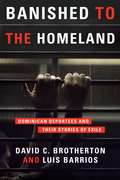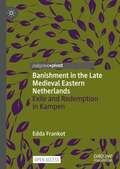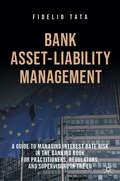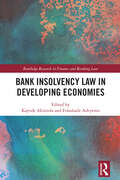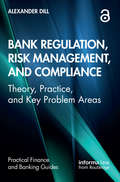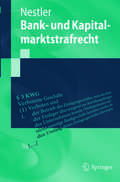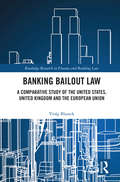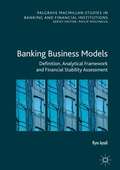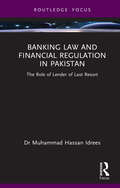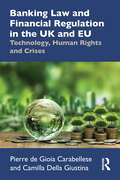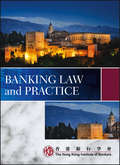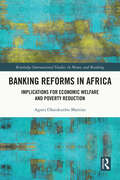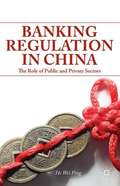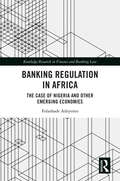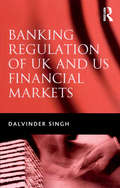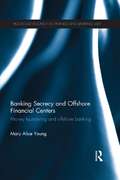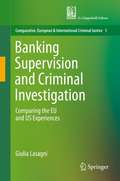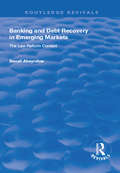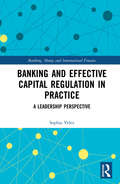- Table View
- List View
Banished Men: How Migrants Endure the Violence of Deportation
by Abigail Leslie AndrewsA free ebook version of this title is available through Luminos, University of California Press’s Open Access publishing program. Visit www.luminosoa.org to learn more. What becomes of men the U.S. locks up and kicks out? From 2009 to 2020, the U.S. deported more than five million people—over 90 percent of them men. In Banished Men, Abigail Andrews and her students tell 186 of their stories. How, they ask, does expulsion shape men's lives and sense of themselves? The book uncovers a harrowing carceral system that weaves together policing, prison, detention, removal, and border militarization to undermine migrants as men. Guards and gangs beat them down, till they feel like cockroaches, pigs, or dogs. Many lose ties with family. They do not go "home." Instead, they end up in limbo: stripped of their very humanity. Against the odds, they fight for new ways to belong. At once devastating and humane, Banished Men offers a clear-eyed critique of the violence of deportation.
Banished to the Homeland: Dominican Deportees and Their Stories of Exile
by David C. Brotherton Luis BarriosThe 1996 U.S. Immigration Reform and Responsibility Act has led to the forcible deportation of tens of thousands of Dominicans from the United States. Following thousands of these individuals over a seven-year period, David C. Brotherton and Luis Barrios use a unique combination of sociological and criminological reasoning to isolate the forces that motivate emigrants to leave their homeland and then commit crimes in the Unites States violating the very terms of their stay. Housed in urban landscapes rife with gangs, drugs, and tenuous working conditions, these individuals, the authors find, repeatedly play out a tragic scenario, influenced by long-standing historical injustices, punitive politics, and increasingly conservative attitudes undermining basic human rights and freedoms. Brotherton and Barrios conclude that a simultaneous process of cultural inclusion and socioeconomic exclusion best explains the trajectory of emigration, settlement, and rejection, and they mark in the behavior of deportees the contradictory effects of dependency and colonialism: the seductive draw of capitalism typified by the American dream versus the material needs of immigrant life; the interests of an elite security state versus the desires of immigrant workers and families to succeed; and the ambitions of the Latino community versus the political realities of those designing crime and immigration laws, which disadvantage poor and vulnerable populations. Filled with riveting life stories and uncommon ethnographic research, this volume relates the modern deportee's journey to broader theoretical studies in transnationalism, assimilation, and social control.
Banishment in the Late Medieval Eastern Netherlands: Exile and Redemption in Kampen
by Edda FrankotThis open access book analyses the practice of banishment and what it can tell us about the values of late medieval society concerning morally acceptable behaviour. It focuses on the Dutch town of Kampen and considers the exclusion of offenders through banishment and the redemption of individuals after their exile. Banishment was a common punishment in late medieval Europe, especially for sexual offences. In Kampen it was also meted out as a consequence of the non-payment of fines, after which people could arrange repayment schemes which allowed them to return. The books firstly considers the legal context of the practice of banishment, before discussing punishment in Kampen more generally. In the third chapter the legal practice of banishment as a punitive and coercive measure is discussed. The final chapter focuses on the redemption of exiles, either because their punishment was completed, or because they arranged for the payment of outstanding fines.
Bank Asset-Liability Management: A Guide to Managing Interest Rate Risk in the Banking Book for Practitioners, Regulators, and Supervisors in the EU
by Fidelio TataThis book provides a practical and intuitive view of how European banks manage asset-liability mismatch risk from both a practitioner and supervisory perspective. After a prolonged period of zero interest rate policy (ZIRP) by central banks around the world, the period from Q1 2022 to Q2 2023 has seen the largest, fastest, and most widespread increase in interest rates since the 1980s, with 1-year euro yields rising by more than 400 bp. The recent market turmoil has exposed the increased vulnerability of banks, particularly those with significant exposures to long-term, fixed income assets, fueled by shorter-term, less stable funding. This challenging interest rate environment reinforces the strategic importance of asset-liability management (ALM) for banks. Indeed, a bank's survival now depends more than ever on prudent ALM. This book introduces the most common components of interest rate risk management within a bank's asset-liability management framework, including the concepts of economic value of equity (EVE), net interest income (NII), funds transfer pricing (FTP), and the replicating model. In addition to bridging the gap between widely used general interest rate risk management techniques in the fixed income area and what is best practice in European banks, the book also provides an update on recent changes in the regulatory framework for European banks' management of interest rate risk in the banking book (IRRBB), including new EBA guidelines. It also covers the latest developments in interest rate risk management, such as rapidly changing interest rates and modeling bank customers' behavior.
Bank Insolvency Law in Developing Economies (Routledge Research in Finance and Banking Law)
by Kayode Akintola Folashade AdeyemoThe subject of bank stability has been under a great amount of political and legislative scrutiny since the mid-2007 to late-2009 global financial crisis. However, these efforts have centred on developed economies. Little coverage is given to strategies adopted by many developing economies. While there is a global discourse on the subject of insolvency generally, there is ample scope to contribute to the growing body of work on the narrow subject of bank insolvencies. This book provides a unique perspective on an emerging theme in at least two respects. First is the focus on selected developing economies and selected developed economies in the EMEA region alongside cross-border developments, with the objective of deciphering the regulatory approach to bank insolvencies. The second is the analytical consideration of methods that may be implemented to preclude or resolve bank insolvencies in developing economies. This book explores the nexus between developing economies and their banking institutions. Developing economies are acutely dependent on their banks for the functioning of their cash-based economies. Recent events, however, suggest a weakness in the long-term viability of some of their banks and a mixed-bag regulatory approach to redress this weakness. This book evaluates the effectiveness of regulatory frameworks in selected developing economies that are designed to prevent or resolve the insolvency of banks. At a time of global economic uncertainty, this book will prove to be a valuable resource to the discourse on the viability of banks, businesses, and economies in developing States.
Bank Regulation, Risk Management, and Compliance: Theory, Practice, and Key Problem Areas (Practical Finance and Banking Guides)
by Alexander DillBank Regulation, Risk Management, and Compliance is a concise yet comprehensive treatment of the primary areas of US banking regulation – micro-prudential, macroprudential, financial consumer protection, and AML/CFT regulation – and their associated risk management and compliance systems. The book’s focus is the US, but its prolific use of standards published by the Basel Committee on Banking Supervision and frequent comparisons with UK and EU versions of US regulation offer a broad perspective on global bank regulation and expectations for internal governance. The book establishes a conceptual framework that helps readers to understand bank regulators’ expectations for the risk management and compliance functions. Informed by the author’s experience at a major credit rating agency in helping to design and implement a ratings compliance system, it explains how the banking business model, through credit extension and credit intermediation, creates the principal risks that regulation is designed to mitigate: credit, interest rate, market, and operational risk, and, more broadly, systemic risk. The book covers, in a single volume, the four areas of bank regulation and supervision and the associated regulatory expectations and firms’ governance systems. Readers desiring to study the subject in a unified manner have needed to separately consult specialized treatments of their areas of interest, resulting in a fragmented grasp of the subject matter. Banking regulation has a cohesive unity due in large part to national authorities’ agreement to follow global standards and to the homogenizing effects of the integrated global financial markets. The book is designed for legal, risk, and compliance banking professionals; students in law, business, and other finance-related graduate programs; and finance professionals generally who want a reference book on bank regulation, risk management, and compliance. It can serve both as a primer for entry-level finance professionals and as a reference guide for seasoned risk and compliance officials, senior management, and regulators and other policymakers. Although the book’s focus is bank regulation, its coverage of corporate governance, risk management, compliance, and management of conflicts of interest in financial institutions has broad application in other financial services sectors.
Bank- und Finanzwirtschaft im Stress: Aktuelle Herausforderungen und Lösungsansätze
by Stephan Schöning Sonja Schütte-Biastoch Nils MochDieses Buch fokussiert die mannigfaltigen Herausforderungen, mit denen die Bank- und Finanzwirtschaft aktuell konfrontiert ist. Digitalisierung, Sustainable Development Goals/Nachhaltigkeit (Green Finance), Globalisierung, Pandemie-Folgen, demografischer Wandel, Ukraine-Krieg und Konsequenzen für die Weltwirtschaft betreffen nicht nur Banken und Sparkassen, den Finanzbereich und das Rechnungswesen von Unternehmen sowie die Wirtschaftsprüfung, sondern sind auch in vielfältiger Natur miteinander verknüpft. Entsprechend sind Akteure im Finanzbereich gefordert, sich auf diese Herausforderungen einzustellen und zukunftsbezogene Lösungsansätze zu entwickeln. Namhafte Expertinnen und Experten aus Wissenschaft und Praxis geben Antworten auf die drängenden Fragen in der Finanzwirtschaft.
Bank- und Kapitalmarktstrafrecht (Springer-Lehrbuch)
by Nina NestlerDas Werk enth#65533;lt eine systematische Darstellung des Bank- und Kapitalmarktstrafrechts. Es umfasst damit diejenigen Felder des Strafrechts, die im Gesch#65533;ftsbereich von Kreditinstituten, Finanzdienstleistungsinstituten oder Wertpapierdienstleistungsunternehmen von besonderer Relevanz sind. Hierzu geh#65533;ren die klassischen Verm#65533;gensdelikte des StGB wie etwa Betrug und Untreue, aber auch spezielle Strafnormen beispielsweise in Kreditwesengesetz oder Wertpapierhandelsgesetz. Das Buch ber#65533;cksichtigt aktuelle Rechtsprechung sowie einschl#65533;gige Neuregelungen, insbesondere solche, die auf unionsrechtlichen Vorgaben beruhen. Gemeinsamkeiten und Spezifika der verschiedenen Teilgebiete werden dabei ebenso erl#65533;utert, wie praktische Zusammenh#65533;nge.
Banking Bailout Law: A Comparative Study of the United States, United Kingdom and the European Union (Routledge Research in Finance and Banking Law)
by Virág BlazsekSetting forth the building blocks of banking bailout law, this book reconstructs a regulatory framework that might better serve countries during future crisis situations. It builds upon recent, carefully selected case studies from the US, the EU, the UK, Spain and Hungary to answer the questions of what went wrong with the bank bailouts in the EU, why the US performed better in terms of crisis management, and how bailouts could be regulated and conducted more successfully in the future. Employing a comparative methodology, it examines the different bailout and bank resolution techniques and tools and identifies the pros and cons of the different legal and regulatory options and their underlying principles. In the post-2008 legal-regulatory architecture financial institution specific insolvency proceedings were further developed or implemented on both sides of the Atlantic. Ten years after the most recent financial crisis, there is sufficient empirical evidence to evaluate the outcomes of the bank bailouts in the US and the EU and to examine a number of cases under the EU’s new bank resolution regime. This book will be of interest of anyone in the field of finance, banking, central banking, monetary policy and insolvency law.
Banking Business Models: Europe (Palgrave Macmillan Studies in Banking and Financial Institutions)
by Rym AyadiThis book is a result of several years of research to provide readers with a novel and comprehensive analysis on business models in banking, essential to understanding bank businesses pre- and post- financial crisis and how they evolve in the financial system. This book will provide depositors, creditors, credit rating agencies, investors, regulators, supervisors, and other market participants with a comprehensive analytical framework and analysis to better understand the nature of risk attached to the bank business models and its contribution to systemic risk throughout the economic cycle. The book will also guide post-graduate students and researchers delving into this topic.
Banking Law and Financial Regulation in Pakistan: The Role of Lender of Last Resort
by Muhammad Hassan IdreesThis book offers an analysis of the contemporary significance of the practice of Lender of Last Resort (LOLR) in Pakistan. Aiming to identify deficiencies in current financial system legislation, the book details the role of LOLR and its essential presence in establishing a resilient banking and financial system.Beginning with an assessment of the emergence of Central Banks as domestic financial regulators, the book draws from the principles of Walter Bagehot and Henry Thornton for LOLR rescue operations. Examining the International Monetary Fund’s (IMF) role as an international lender of last resort and scrutinising its rescue efforts, the book uses case studies of the Central Banks in the United Kingdom and the United States to suggest reforms for Pakistan’s system. It explores the causes of financial crises and evaluates the factors that have made LOLR an integral part of Central Banks’ responsibilities. It compares LOLR operations in the cases of AIG and Lehman Brothers in the United States and Northern Rock in the United Kingdom, comparing these two cases in Pakistan to pinpoint key gaps in the State Bank of Pakistan’s LOLR operations. Furthermore, it discusses the Basel Accord I, II, and III: the key international regulations for the banking sector.The book will be of interest to scholars and students in the field of financial and banking law.
Banking Law and Financial Regulation in the UK and EU: Technology, Human Rights and Crises
by Pierre de Gioia Carabellese Camilla Della GiustinaBanking Law and Financial Regulation in the UK and EU seeks to blend orthodox topics covered within the banking and financial law syllabus, such as sources of banking and financial law, financial markets, financial and banking institutions, financial transactions, and banking and financial insolvency, with a careful analysis of emerging issues and more contemporary topics.This advanced-level textbook offers a new format for the study of banking and financial law, placing it within the wider context of economic development. As such, two elements are integral to this new methodology: the rise of techno-banking and digitalisation of the financial sector, and Brexit. Departing from the approaches of more traditional textbooks in this area, the book also takes a comparative approach to UK and EU banking law, highlighting the legal consequences of the UK’s exit from the EU. Aspects of human rights are integrated throughout and current debates and developments around financial crises – the advancement of technological innovations in the banking sector and contemporary topics, such as health crises, energy, and ESG and the environment – is taken into account to provide the reader with the opportunity to develop their own autonomous and broader understanding of the various concepts.Banking Law and Financial Regulation in the UK and EU will be a valuable text for students taking advanced undergraduate and postgraduate-level courses in banking law and financial law, as well as practising lawyers, managers and accountants.
Banking Law and Practice
by The Hong Kong Institute of BankersA solid understanding of how banks operate is crucial to grasp the functioning of modern society. Banks are an intrinsic part of business, finance, and everyday life. Modern banking is regulated by a sophisticated set of laws and regulations that are constantly evolving. Banking Law and Practice from the Hong Kong Institute of Bankers outlines and explains these laws and regulations clearly and in detail. This regulatory framework has a deep impact on banks, bankers, and anyone that deals with them, which is the overwhelming majority of society. This high level of impact makes Banking Law and Practice an important book as well as a necessary and authoritative reference for industry professionals, students, and the public at large. Banking Law and Practice discusses a range of topics that have a direct bearing on the day-to-day operations of banks, from contracts to how to ensure safe and secure lending. It examines the development and current state of banking legislation and regulation and facilitates bankers and their institutions to shape their practice to meet all the necessary legal and regulatory requirements. Students, industry professionals, and the public at large will welcome the thorough and clear explanations of the legal and regulatory framework in which banks operate. This book is essential reading for candidates studying for the HKIB Associateship Examination and anyone else seeking expert knowledge of the legal and regulatory structure affecting banks in Hong Kong. Topics covered in this book include: Contractual Relationships Code of Banking Practice Money Laundering Negotiable Instruments Law Related to Securities Bankruptcy and Insolvency
Banking Law: Private Transactions and Regulatory Frameworks
by Andreas Kokkinis Andrea MiglionicoBanking regulation and the private law governing the bank-customer relationship came under the spotlight as a result of the global financial crisis of 2007–2009. More than a decade later UK, EU and international regulatory initiatives have transformed the structure, business practices, financing models and governance of the banking sector. This authoritative text offers an in-depth analysis of modern banking law and regulation, while providing an assessment of its effectiveness and normative underpinnings. Its main focus is on UK law and practice, but where necessary it delves into EU law and institutions, such as the European Banking Union and supervisory role of the European Central Bank. The book also covers the regulation of bank corporate governance and executive remuneration, the promises and perils of FinTech and RegTech, and the impact of Brexit on UK financial services. Although detailed, the text remains easy to read and reasonably short; pedagogic features such as a glossary of terms and practice questions for each chapter are intended to facilitate learning. It is a useful resource for students and scholars of banking law and regulation, as well as for regulators and other professionals who are interested in reading a precise and evaluative account of this evolving area of law.
Banking On It: How I Disrupted an Industry
by Anne BodenONE WOMAN'S QUEST TO REBUILD BRITAIN'S BROKEN BANKING SYSTEM'If there was ever a business book suitable for TV adaptation, this is it' FTIn the aftermath of the 2008 financial crash, the British banking industry had come to a standstill. Trust in the sector had been left in tatters and, despite the emergence of technologies which could revolutionise the customer experience, nobody wanted to upset the status quo.That was until Anne Boden decided to do something radical and start her own bank.Founder of Starling Bank, winner of Best British Bank three years running, in this awe-inspiring story Anne reveals how she broke through bureaucracy, successfully tackled prejudice to realise her vision for the future of consumer banking and revolutionised the entire industry forever.***ONE OF THE TIMES TOP 5 BEST BUSINESS BOOKS OF THE YEAR 2020***'A banking blockbuster' The Observer Magazine'Sent shockwaves through the tight-knit world of UK tech and venture capital' Yahoo Finance
Banking Reforms in Africa: Implications for Economic Welfare and Poverty Reduction (Routledge International Studies in Money and Banking)
by Agnes Olatokunbo MartinsThis book comprehensively explores the intricate relationship between banking reforms, economic well-being, and poverty reduction across the African continent. Delving into the historical roots of banking reforms, it examines the resilience of banking sectors in key African countries like South Africa, Nigeria, Kenya, MENA, and beyond.The findings suggest that much attention should be paid to the design of banking systems and how banks are regulated. This focus on banks differs from many discussions on the topic, which tend to be more concerned with other policy areas such as economic policy, international trade policy, and aid. The book’s extensive and contemporary overview of banking reforms enables a comparative analysis of regulatory frameworks, supervision practices, and government interventions. It evaluates theoretical frameworks linking banking reforms to bank stability and resilience, drawing on financial intermediation, resource allocation, systemic risk, and financial development concepts. It empirically tests the causal relationships between the Basel II/III capital reforms, bank sector resilience, economic growth, and poverty reduction and identifies and analyses the channels and mechanisms through which banking reforms affect economic welfare and poverty reduction in Africa, such as credit availability, financial efficiency, financial innovation, and financial access.The book offers an insightful exploration into a brighter economic future on the African continent. The findings presented herein offer valuable insights for policymakers, researchers, and practitioners striving to enhance financial stability, foster economic growth, and alleviate poverty in Africa.
Banking Regulation In China
by He Wei PingBanking Regulation in China provides an in-depth analysis of the country's contemporary banking regulatory system, focusing on regulation in practice. By drawing on public and private interest theories relating to bank regulation, He argues that controlled development of the banking sector transformed China's banks into more market-oriented institutions and increased public sector growth. This work proves that bank regulation is the primary means through which the Chinese government achieves its political and economic objectives rather than using it as a vehicle for maintaining efficient financial markets.
Banking Regulation in Africa: The Case of Nigeria and Other Emerging Economies (Routledge Research in Finance and Banking Law)
by Folashade AdeyemoThere is scarce literature on the development of banking regulation in Nigeria, or the scope of powers of the Central Bank of Nigeria, which is its core banking sector regulator. The critical impetus of this book is to contribute to the literature of this area, with a detailed exploration of the Nigerian regulatory architecture. In addition, the book also engages in a comparative analysis with two emerging economies in Africa: South Africa and Kenya. It also considers the UK and the US as comparator jurisdictions in light of their regulatory responses to the global financial crisis of 2008. This book contributes to the ongoing discourse in this area by exploring, in detail, the theoretical underpinnings of regulation and supervision, to determine whether there is an understanding of what constitutes effective regulation in these jurisdictions. Given that Nigeria is the core jurisdictional focus, a historical account of banking exchanges from the pre-colonial era to more recent times is provided. Offering an understanding of how political, local and economic settings, in conjunction with the theories of regulation have impacted and influenced regulatory development in Nigeria, the book engages in an examination of Nigeria’s historical experiences with bank failures, including the banking crisis it experienced in 2008. The newly enacted Banks and Other Financial Institutions Act 2020 is also explored as part of this discourse. Through a critical analysis of the law, the book demonstrates that the Nigerian regulator has historically adopted a reactionary strategy, instead of a proactive and pragmatic approach, which is imperative for an effective regulatory regime. The outcome of this analysis is that there are lessons to be learned, and proposals are discussed in order to rethink the act of banking regulation.
Banking Regulation of UK and US Financial Markets
by Dalvinder SinghDalvinder Singh provides an interdisciplinary analysis of the legal aspects of prudential supervision. This gives the reader a broader understanding of the core processes of banking supervision. By using the UK as a case study, a comparison is made with the US to illustrate the different ways of approaching the issues. The author examines the legal as well as the theoretical, economic, political and policy issues that underpin the purpose of prudential supervision, such as corporate governance, enforcement sanctions, the role of external auditors and accountability of financial regulators. These are considered in the context of broad-policy considerations which render prudential supervision necessary, namely financial stability and depositor protection. The book will be of interest to academics, policymakers, regulators and practitioners, and equally will serve specialist undergraduate and postgraduate programmes in law, management and economics which focus on financial regulation.
Banking Secrecy and Global Finance: Economic And Political Issues
by Donato Masciandaro Olga BalakinaA 2009 G20 official document stated that the era of banking secrecy is over but is it? If banking secrecy is the result of market mechanisms, it suggests that worldwide demand and supply are likely to remain for a long time to come. Since the Global Financial Crisis, many countries have fought to combat banking secrecy, yet it permeates both national and international industries, and global efforts to prevent banking secrecy have been ineffective or at worst counterproductive. In this book, the authors show how the growth of criminal activity has systematically generated a demand for banking secrecy. They explore how national politicians and international banks have been motivated to supply banking secrecy through economic and political incentives, and shed light on the economics and politics of banking secrecy. This book takes a multidisciplinary approach to reveal the variety of behaviours and processes involved in making dirty money appear clean, providing an in-depth study of financial transactions which are characterized by a special purpose: hiding the originally illegal sources. This work will be of interest to students and scholars of economics and finance, and those with an interest in banking secrecy, global finance, international banking, and financial regulation.
Banking Secrecy and Offshore Financial Centers: Money laundering and offshore banking (Routledge Research in Finance and Banking Law)
by Mary Alice YoungThis book brings together the issues surrounding banking secrecy and confiscation of criminal proceeds. The book examines the existing legal agreements at the international, regional and national levels and their interaction in the substantive areas of confiscation, anti-money laundering and banking confidentiality laws. It looks at how these agreements have been applied in offshore financial centers and demonstrates that despite a number of legally binding UN Conventions as well as global anti-money laundering recommendations, the implementation of them is often lukewarm by those Parties who have ratified the Convention and adopted obligations, because of this the confiscation legislation is incompatible with strict banking confidentiality laws. The work draws on the experience of criminologists to offer critical insight into the legislative frameworks designed to deal with banking secrecy and confiscation in offshore financial centers. It goes on to offer suggestions for measures that may be taken by major economies to circumvent the lack of cooperation by offshore financial centers as intolerance towards money laundering grows in light of recent political and economic events. This book will be of particular interest to students and scholars of Law, Finance and Criminology.
Banking Supervision and Criminal Investigation: Comparing the EU and US Experiences (Comparative, European and International Criminal Justice #1)
by Giulia LasagniIn the aftermath of the last financial crisis, on both sides of the Atlantic banking supervisors were given new supervisory and enforcement powers, which are often of a substantially punitive-criminal nature. In Europe in particular, the establishment of the Single Supervisory Mechanism within the European Central Bank substantially increased centralised investigatory and sanctioning powers. This major innovation, together with the development of forms of real-time monitoring of banking (often digital) records, challenges traditional banking criminal investigations in their national-based and analogue dimension.The book offers a comprehensive account and perspective analysis of the interactions between the criminal and administrative nature of such new powers, highlighting their “punitive” overall nature and their impact on fundamental rights. Covering both the US and the EU regulatory frameworks, it presents unprecedented, trans-systemic research between criminal law and procedure, and between regulatory and administrative law, at the international, European and national level.The book also includes a rich and detailed selection of case law from the US and the European supreme courts, with a specific focus on CJEU and ECtHR decisions.
Banking and Debt Recovery in Emerging Markets: The Law Reform Context (Routledge Revivals)
by Sonali AbeyratneThis title was first published in 2001. A developing country that is pursuing free market economic policies requires a modern commercial law infrastructure, which enables the emerging economy to have in place properly functioning credit and other financial systems which stimulate domestic and foreign investment. This book provides a comparative analysis of the law and practice of debt recovery in India, Sri Lanka and Malaysia, demonstrating that a suitable debt-recovery system for a developing economy requires not only good laws and judicial remedies, but also appropriate financial industry practices such as credit and loan supervision policies.
Banking and Effective Capital Regulation in Practice: A Leadership Perspective (Banking, Money and International Finance)
by Sophia VelezDue to a historical lack of attention to the importance of modelling, measuring and managing risk, senior bank leaders are struggling to implement unified practices within their financial institutions that could address the gaps posed by risky management behaviour, rogue trading, liquidity crises, prohibited investments in mortgage-backed securities, and default risks aligned with loans. This book discusses the theories at play between bank agents (bank managers) and their principals (shareholders), a topic which has gained importance as a result of the banking crisis, and similarly, governed the need for more efficient risk management and ethical managerial practices. The author worked with a senior bank leadership team to identify and describe effective capital regulation practices that can lead to a reduction in loss and risky management behavioural practices. The book offers consensus on a number of activities that bank managers can implement to address bank risk. It analyses the relevant factors that determine the necessity for banking regulation and the important role of regulation in managing banking crises. The author’s analysis of the important regulatory aspects in developed countries such as the US, offers a useful conceptual framework for creating an adequate banking regulatory environment in developing countries. This book offers an original contribution to the field of banking that undergraduate, masters, PhD students, academics and researchers can use to gain a deeper understanding of the constructs at play in the banking industry.

